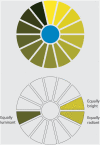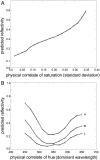The brightness of colour
- PMID: 19333398
- PMCID: PMC2659800
- DOI: 10.1371/journal.pone.0005091
The brightness of colour
Abstract
Background: The perception of brightness depends on spatial context: the same stimulus can appear light or dark depending on what surrounds it. A less well-known but equally important contextual phenomenon is that the colour of a stimulus can also alter its brightness. Specifically, stimuli that are more saturated (i.e. purer in colour) appear brighter than stimuli that are less saturated at the same luminance. Similarly, stimuli that are red or blue appear brighter than equiluminant yellow and green stimuli. This non-linear relationship between stimulus intensity and brightness, called the Helmholtz-Kohlrausch (HK) effect, was first described in the nineteenth century but has never been explained. Here, we take advantage of the relative simplicity of this 'illusion' to explain it and contextual effects more generally, by using a simple Bayesian ideal observer model of the human visual ecology. We also use fMRI brain scans to identify the neural correlates of brightness without changing the spatial context of the stimulus, which has complicated the interpretation of related fMRI studies.
Results: Rather than modelling human vision directly, we use a Bayesian ideal observer to model human visual ecology. We show that the HK effect is a result of encoding the non-linear statistical relationship between retinal images and natural scenes that would have been experienced by the human visual system in the past. We further show that the complexity of this relationship is due to the response functions of the cone photoreceptors, which themselves are thought to represent an efficient solution to encoding the statistics of images. Finally, we show that the locus of the response to the relationship between images and scenes lies in the primary visual cortex (V1), if not earlier in the visual system, since the brightness of colours (as opposed to their luminance) accords with activity in V1 as measured with fMRI.
Conclusions: The data suggest that perceptions of brightness represent a robust visual response to the likely sources of stimuli, as determined, in this instance, by the known statistical relationship between scenes and their retinal responses. While the responses of the early visual system (receptors in this case) may represent specifically the statistics of images, post receptor responses are more likely represent the statistical relationship between images and scenes. A corollary of this suggestion is that the visual cortex is adapted to relate the retinal image to behaviour given the statistics of its past interactions with the sources of retinal images: the visual cortex is adapted to the signals it receives from the eyes, and not directly to the world beyond.
Conflict of interest statement
Figures







Similar articles
-
Colour and brightness coding in the central nervous system: theoretical aspects and visual evoked potentials to homogeneous red and green stimuli.Proc R Soc Lond B Biol Sci. 1986 Feb 22;227(1246):53-66. doi: 10.1098/rspb.1986.0009. Proc R Soc Lond B Biol Sci. 1986. PMID: 2870500
-
CAM18sl brightness prediction for unrelated saturated stimuli including age effects.Opt Express. 2021 Aug 30;29(18):29257-29274. doi: 10.1364/OE.431382. Opt Express. 2021. PMID: 34615039
-
No functional magnetic resonance imaging evidence for brightness and color filling-in in early human visual cortex.J Neurosci. 2006 Apr 5;26(14):3634-41. doi: 10.1523/JNEUROSCI.4382-05.2006. J Neurosci. 2006. PMID: 16597716 Free PMC article. Clinical Trial.
-
The role of luminance and chromatic cues in emmetropisation.Ophthalmic Physiol Opt. 2013 May;33(3):196-214. doi: 10.1111/opo.12050. Ophthalmic Physiol Opt. 2013. PMID: 23662955 Review.
-
The neurophysiological correlates of colour induction, colour and brightness contrast.Prog Brain Res. 1993;95:45-53. doi: 10.1016/s0079-6123(08)60356-8. Prog Brain Res. 1993. PMID: 8493352 Review.
Cited by
-
Uniform trichromacy in Alouatta caraya and Alouatta seniculus: behavioural and genetic colour vision evaluation.Front Zool. 2021 Jul 8;18(1):36. doi: 10.1186/s12983-021-00421-0. Front Zool. 2021. PMID: 34238318 Free PMC article.
-
Under the sun: adaptation effects to changes in facial complexion.BMC Psychol. 2023 Apr 1;11(1):96. doi: 10.1186/s40359-023-01148-9. BMC Psychol. 2023. PMID: 37005648 Free PMC article.
-
Improved shimming for fMRI specifically optimizing the local BOLD sensitivity.Neuroimage. 2010 Jan 1;49(1):327-36. doi: 10.1016/j.neuroimage.2009.08.010. Epub 2009 Aug 12. Neuroimage. 2010. PMID: 19682587 Free PMC article.
-
Built environment color modulates autonomic and EEG indices of emotional response.Psychophysiology. 2022 Dec;59(12):e14121. doi: 10.1111/psyp.14121. Epub 2022 Jun 20. Psychophysiology. 2022. PMID: 35723272 Free PMC article.
-
Effect of the Decrease in Luminance Noise Range on Color Discrimination of Dichromats and Trichromats.Front Behav Neurosci. 2018 Nov 23;12:292. doi: 10.3389/fnbeh.2018.00292. eCollection 2018. Front Behav Neurosci. 2018. PMID: 30532699 Free PMC article.
References
-
- Fairchild MD. Color Appearance Models. 1st ed. Reading, , MS: Addison Wesley; 1998.
-
- Sharpe LT, Stockman A, Jagla W, Jägle H. A luminous efficiency function, V*(lambda), for daylight adaptation. J Vis. 2005;5:948–68. - PubMed
-
- Lennie P, Pokorny J, Smith VC. Luminance. J Opt Soc Am A. 1993;10:1283–1293. - PubMed
-
- Pridmore RW. Effects of luminance, wavelength and purity on the color attributes: Brief review with new data and perspectives. Color Research & Application. 2007;32:208–222.
Publication types
MeSH terms
Grants and funding
LinkOut - more resources
Full Text Sources
Miscellaneous

